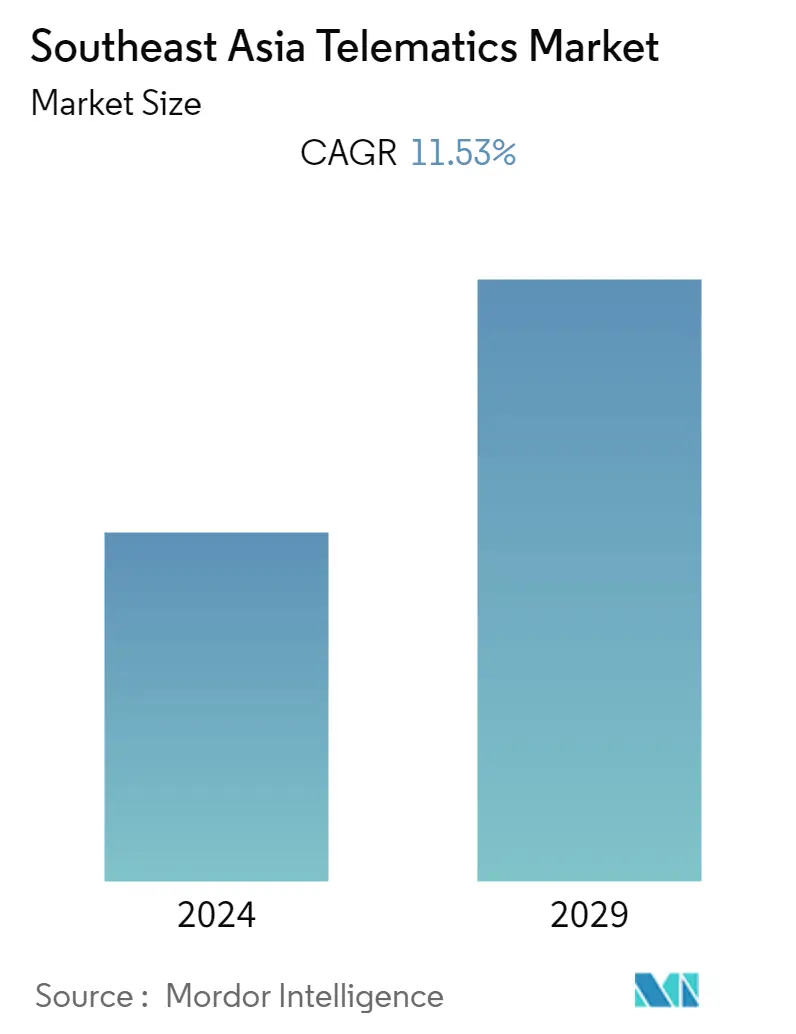Market Size of Southeast Asia Telematics Industry

| Study Period | 2019 - 2029 |
| Base Year For Estimation | 2023 |
| Forecast Data Period | 2024 - 2029 |
| Historical Data Period | 2019 - 2022 |
| CAGR | 11.53 % |
| Market Concentration | Low |
Major Players
*Disclaimer: Major Players sorted in no particular order |
Southeast Asia Telematics Market Analysis
The market volume of telematics systems in Southeast Asia was 1.89 million units in the previous years, and it is expected to reach 3.57 million units, registering a CAGR of 11.53% during the forecast period. Telematics refers to the set of technologies used to monitor a broad range of information concerning an individual vehicle or fleet. Telematics systems can gather information, including driver behavior, tracking location, engine diagnostics, and vehicle activity. Along with these, it can also help fleet operators to visualize the data generated on the software platform to manage their resources.
- As modern telematics systems help drivers by heightening their awareness of their driving behaviors through tools such as driver safety scorecards, tech assistance for driver training programs and accidents, and optimal driving condition reports, the increasingly stringent government regulations pertaining to driver and vehicle safety are creating a favorable outlook for the growth of the market studied.
- The expansion of high-speed telecommunication networks in the Southeast Asian region is anticipated to work in favor of the market studied, as seamless internet connectivity is among the key infrastructural requirement for the telematics systems to work properly. For instance, according to Ericsson, growing 4G mobile broadband uptake is emerging to be among the key factor in digital acceleration, including Oceania, service providers in the region were expected to add about 90 million 4G subscriptions by last year, with strong growth projected to continue this year.
- Considering the growth potential the Southeast Asian region holds, several vendors offering telematics solutions are expanding their presence in this region. For instance, in November 2022, OPES, a digital-only insurance firm, partnered with IMS to offer app-based telematics insurance solutions in Vietnam. According to the company, this insurance offering will be the first wholly digital, telematics-based auto insurance solution in Vietnam.
- Hence, the expansion of the commercial vehicle industry, along with the industry's shift towards connected fleets and optimized operations, is anticipated to remain among the primary factors driving the market's growth in the region. The growing entry of global players is expected to drive competitiveness among the players and is anticipated to influence the technological landscape of the market studied during the forecast period.
- However, the higher cost of telematics systems, lack of standardization of products, and increasing cybersecurity threats are among the major factors restraining the growth of the market studied. A lower awareness among individual commercial vehicles and small fleet operators also challenges the development of the market studied.
- Macroeconomic factors play a crucial role in the growth of the Southeast Asian automotive sector, which, in turn, also influences the dynamics of the regional telematics industry. Factors such as the growing GDP or the purchasing capability of the consumers and supportive government regulations lead to higher sales.
Southeast Asia Telematics Industry Segmentation
The telematics market involves using a set of technologies to monitor a wide range of information concerning an individual vehicle or fleet. The analysis is based on the market insights captured through primary and secondary research. The market covers the economic factors impacting the growth of the Southeast Asian telematics market in terms of drivers and restraints.
The scope of the study is limited to the commercial vehicle market in Southeast Asia. The scope includes both aftermarket and OEM-embedded telematics systems in commercial vehicles. The commercial vehicle types considered include light commercial vehicles (LCV) and medium and heavy commercial vehicles (M/HCV). The hardware units tracked in the study include telematics systems such as GPS Trackers, OBD dongles, backboxes, and telematics control units. Vendor ranking analysis of top vendors is also included as part of the deliverables.
The Southeast Asian Telematics Market is segmented by Type of Vehicle (LCV, M/HCV) and Country (Thailand, Indonesia, Malaysia, and the Rest of Southeast Asia). The market sizes and forecasts are provided in terms of volume (units) for all the above segments.
| By Type of Vehicle | |
| LCV | |
| M/HCV |
| By Country | |
| Thailand | |
| Indonesia | |
| Malaysia | |
| Rest of Southeast Asia |
Southeast Asia Telematics Market Size Summary
The Southeast Asia telematics market is poised for significant growth, driven by the increasing adoption of advanced technologies that monitor various aspects of vehicle and fleet operations. Telematics systems, which encompass driver behavior monitoring, location tracking, engine diagnostics, and vehicle activity analysis, are becoming essential tools for fleet operators. The market is benefiting from the expansion of high-speed telecommunications networks, which are crucial for the seamless operation of these systems. The region's shift towards connected fleets and optimized operations, coupled with stringent government regulations on driver and vehicle safety, is creating a favorable environment for market expansion. The entry of global players is enhancing competition and influencing the technological landscape, although challenges such as high costs, lack of standardization, and cybersecurity threats persist.
The demand for light commercial vehicles (LCVs) is expected to rise, supported by rapid industrialization and the growth of the e-commerce sector in Southeast Asia. LCVs, known for their low operational costs and agility, are integral to logistics solutions, particularly in urban areas. The region's manufacturing sector, especially in countries like Malaysia and Indonesia, is contributing to this demand, with LCVs playing a crucial role in transportation and distribution. Indonesia, with its burgeoning infrastructure and industrial sectors, is witnessing a surge in commercial vehicle demand, driven by industries such as mining and manufacturing. Despite past challenges due to the pandemic, the market is recovering, with government initiatives promoting fleet modernization and emission control. The competitive landscape is fragmented, with numerous players offering specialized solutions, and recent developments indicate a trend towards innovative business models and value-added services.
Southeast Asia Telematics Market Size - Table of Contents
-
1. MARKET INSIGHTS
-
1.1 Market Overview
-
1.2 Analysis of Business Models and Solutions
-
1.3 Assessment of the Impact of Macroeconomic Trends on the Industry
-
1.4 Industry Attractiveness - Porter's Five Forces Analysis
-
1.4.1 Bargaining Power of Suppliers
-
1.4.2 Bargaining Power of Buyers
-
1.4.3 Threat of New Entrants
-
1.4.4 Threat of Substitute Products
-
1.4.5 Intensity of Competitive Rivalry
-
-
1.5 Industry Value Chain Analysis
-
1.6 Regulations/Policies/Mandates
-
-
2. MARKET SEGMENTATION
-
2.1 By Type of Vehicle
-
2.1.1 LCV
-
2.1.2 M/HCV
-
-
2.2 By Country
-
2.2.1 Thailand
-
2.2.2 Indonesia
-
2.2.3 Malaysia
-
2.2.4 Rest of Southeast Asia
-
-
Southeast Asia Telematics Market Size FAQs
What is the current Southeast Asia Telematics Market size?
The Southeast Asia Telematics Market is projected to register a CAGR of 11.53% during the forecast period (2024-2029)
Who are the key players in Southeast Asia Telematics Market?
DTC Enterprise, GPSiam, Forth Tracking System, Thai GPS Tracker and Guarantee GPS are the major companies operating in the Southeast Asia Telematics Market.

